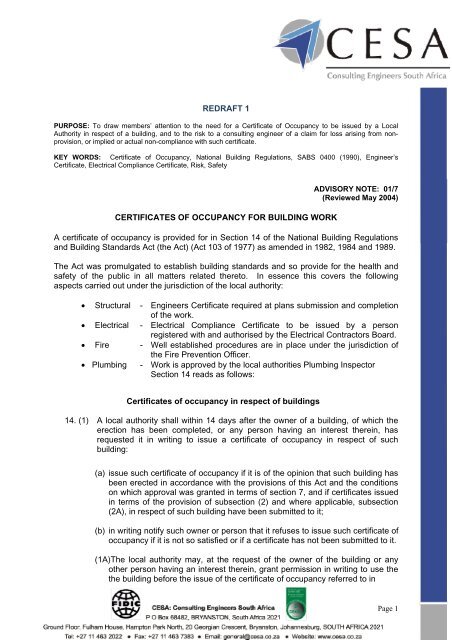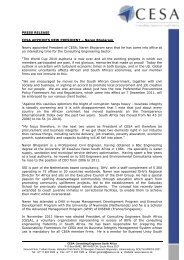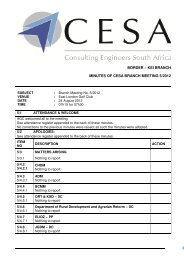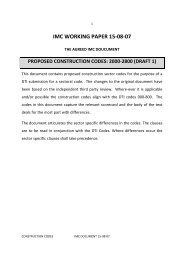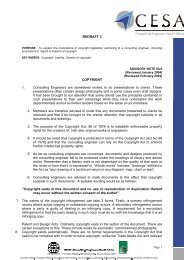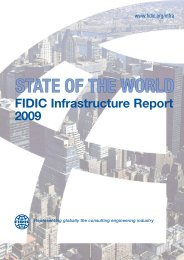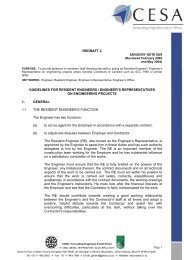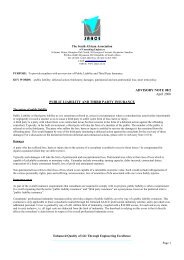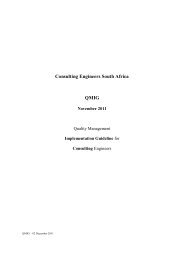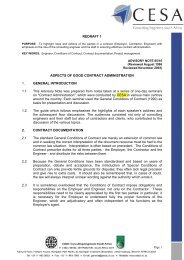certificates of occupancy for building work - Cesa
certificates of occupancy for building work - Cesa
certificates of occupancy for building work - Cesa
Create successful ePaper yourself
Turn your PDF publications into a flip-book with our unique Google optimized e-Paper software.
REDRAFT 1<br />
PURPOSE: To draw members’ attention to the need <strong>for</strong> a Certificate <strong>of</strong> Occupancy to be issued by a Local<br />
Authority in respect <strong>of</strong> a <strong>building</strong>, and to the risk to a consulting engineer <strong>of</strong> a claim <strong>for</strong> loss arising from nonprovision,<br />
or implied or actual non-compliance with such certificate.<br />
KEY WORDS: Certificate <strong>of</strong> Occupancy, National Building Regulations, SABS 0400 (1990), Engineer’s<br />
Certificate, Electrical Compliance Certificate, Risk, Safety<br />
CERTIFICATES OF OCCUPANCY FOR BUILDING WORK<br />
ADVISORY NOTE: 01/7<br />
(Reviewed May 2004)<br />
A certificate <strong>of</strong> <strong>occupancy</strong> is provided <strong>for</strong> in Section 14 <strong>of</strong> the National Building Regulations<br />
and Building Standards Act (the Act) (Act 103 <strong>of</strong> 1977) as amended in 1982, 1984 and 1989.<br />
The Act was promulgated to establish <strong>building</strong> standards and so provide <strong>for</strong> the health and<br />
safety <strong>of</strong> the public in all matters related thereto. In essence this covers the following<br />
aspects carried out under the jurisdiction <strong>of</strong> the local authority:<br />
• Structural - Engineers Certificate required at plans submission and completion<br />
<strong>of</strong> the <strong>work</strong>.<br />
• Electrical - Electrical Compliance Certificate to be issued by a person<br />
registered with and authorised by the Electrical Contractors Board.<br />
• Fire - Well established procedures are in place under the jurisdiction <strong>of</strong><br />
the Fire Prevention Officer.<br />
• Plumbing - Work is approved by the local authorities Plumbing Inspector<br />
Section 14 reads as follows:<br />
Certificates <strong>of</strong> <strong>occupancy</strong> in respect <strong>of</strong> <strong>building</strong>s<br />
14. (1) A local authority shall within 14 days after the owner <strong>of</strong> a <strong>building</strong>, <strong>of</strong> which the<br />
erection has been completed, or any person having an interest therein, has<br />
requested it in writing to issue a certificate <strong>of</strong> <strong>occupancy</strong> in respect <strong>of</strong> such<br />
<strong>building</strong>:<br />
(a) issue such certificate <strong>of</strong> <strong>occupancy</strong> if it is <strong>of</strong> the opinion that such <strong>building</strong> has<br />
been erected in accordance with the provisions <strong>of</strong> this Act and the conditions<br />
on which approval was granted in terms <strong>of</strong> section 7, and if <strong>certificates</strong> issued<br />
in terms <strong>of</strong> the provision <strong>of</strong> subsection (2) and where applicable, subsection<br />
(2A), in respect <strong>of</strong> such <strong>building</strong> have been submitted to it;<br />
(b) in writing notify such owner or person that it refuses to issue such certificate <strong>of</strong><br />
<strong>occupancy</strong> if it is not so satisfied or if a certificate has not been submitted to it.<br />
(1A)The local authority may, at the request <strong>of</strong> the owner <strong>of</strong> the <strong>building</strong> or any<br />
other person having an interest therein, grant permission in writing to use the<br />
the <strong>building</strong> be<strong>for</strong>e the issue <strong>of</strong> the certificate <strong>of</strong> <strong>occupancy</strong> referred to in<br />
Page 1
subsection (1), <strong>for</strong> such period and on such conditions as may be extended or<br />
altered, as the case may be, by such local authority.<br />
(1) Any person licensed or authorized by a local authority to carry out the installation,<br />
alteration or repair <strong>of</strong> any electrical wiring connected or <strong>of</strong> which connection is<br />
desired with the electrical supply or distribution <strong>work</strong>s <strong>of</strong> such local authority or<br />
any statutory body, shall, at the request <strong>of</strong> the owner <strong>of</strong> a <strong>building</strong> <strong>of</strong> which the<br />
erection has been completed or <strong>of</strong> any person having an interest therein, issue a<br />
certificate if he is satisfied that the electrical wiring and other electrical installations<br />
in such <strong>building</strong> are in accordance with the provisions <strong>of</strong> all applicable laws.<br />
(2A) A pr<strong>of</strong>essional engineer or other competent person approved by the local<br />
authority who has been appointed to design or inspect the erection <strong>of</strong> the<br />
structural system <strong>of</strong> any <strong>building</strong> shall, after the completion <strong>of</strong> such structural<br />
system, submit to the local authority in question a certificate indicating that such<br />
such structural system is in accordance with the application in respect <strong>of</strong><br />
which approval was granted in terms <strong>of</strong> section 7.<br />
(2) Any person who <strong>for</strong> the purposes <strong>of</strong> subsection (1):<br />
(a) submits a certificate contemplated in subsection (2) which is substantially<br />
false or incorrect, knowing the same to be false or incorrect;<br />
(b) in a fraudulent manner issues or obtains a certificate contemplated in<br />
subsection (2).<br />
shall be guilty <strong>of</strong> an <strong>of</strong>fence.<br />
(4)(a) The owner <strong>of</strong> any <strong>building</strong> or, any person having an interest therein, erected or<br />
being erected with the approval <strong>of</strong> a local authority, who occupies or uses such <strong>building</strong> or<br />
permits the occupation or use <strong>of</strong> such <strong>building</strong>:<br />
(i)<br />
(ii)<br />
(iii)<br />
(iv)<br />
unless a certificate <strong>of</strong> <strong>occupancy</strong> has been issued in terms <strong>of</strong> subsection<br />
(1)(a) in respect <strong>of</strong> such <strong>building</strong>;<br />
except in so far as it is essential <strong>for</strong> the erection <strong>of</strong> such <strong>building</strong>;<br />
during any period not being the period in respect <strong>of</strong> which such local authority<br />
has granted permission in writing <strong>for</strong> the occupation or use <strong>of</strong> such <strong>building</strong> or<br />
in contravention <strong>of</strong> any condition on which such permission has been granted;<br />
or,<br />
otherwise than in such circumstances and on such conditions as may be<br />
prescribed by national <strong>building</strong> regulation,<br />
shall be guilty <strong>of</strong> an <strong>of</strong>fence.<br />
The following from Section 24 <strong>of</strong> the Act<br />
An <strong>of</strong>fence is punishable, on conviction, by a fine not exceeding R4 000 or <strong>for</strong> a<br />
period <strong>of</strong> imprisonment not exceeding 12 months.<br />
The following from Regulation A25(6)<strong>of</strong> the Regulations (Administration) <strong>of</strong> the Act<br />
The local authority may serve a notice on any person contemplated in section 4(4) <strong>of</strong><br />
the Act or sub-Regulation (4) or (5), ordering such person <strong>for</strong>thwith to stop the<br />
erection <strong>of</strong> a <strong>building</strong> concerned or to comply with such approval, as the case may<br />
be; Provided that where any deviation is found to be necessary during the course <strong>of</strong><br />
Page 2
construction <strong>of</strong> such <strong>building</strong>, the local authority may authorize the <strong>work</strong> to continue<br />
but shall require that an amended plan, drawing or particulars to cover such deviation<br />
is submitted and approved be<strong>for</strong>e a certificate <strong>of</strong> <strong>occupancy</strong> is issued.<br />
The Act is currently implemented through the publication by the South African Bureau <strong>of</strong><br />
Standards Standard 0400 <strong>of</strong> 1990. The relevant section, in its commentary at clause 3<br />
(Local Authority Powers Under the Act) reads, in this context:<br />
Most <strong>of</strong> the powers required by a local authority in the process <strong>of</strong> en<strong>for</strong>cing the<br />
regulations are contained in Act 103,<br />
these include at sub-clause (f):<br />
(f) section 14, which imposes a duty on the local authority to issue a “certificate <strong>of</strong><br />
<strong>occupancy</strong>” if it is satisfied that the completed <strong>building</strong> has been erected in<br />
accordance with the regulations;<br />
The person in the local authority to issue the certificate <strong>of</strong> <strong>occupancy</strong> would be the Building<br />
Control Officer or his delegated person, such as the relevant local <strong>building</strong> inspector.<br />
A reading <strong>of</strong> the Act at clause 14(1) makes it primarily the responsibility <strong>of</strong> the owner <strong>of</strong> a<br />
<strong>building</strong> to apply <strong>for</strong> a certificate <strong>of</strong> <strong>occupancy</strong>. However, a ‘person having an interest<br />
therein’ could be a principal agent such as an architect or engineer. A problem could be the<br />
“innocent” <strong>building</strong> owner looking to his pr<strong>of</strong>essionals and insisting they have, at least, a duty<br />
<strong>of</strong> care to draw to the <strong>building</strong> owner’s attention the need to apply <strong>for</strong> the certificate and to<br />
deal with any outcoming matters.<br />
A recent Appeal Court decision in the case S M Goldstein & Co (Pty) Ltd v Cathkin Park<br />
Hotel (Pty) Ltd and Another it was found that a contractor may be held liable <strong>for</strong> negligence in<br />
a fire loss. This opens the door to claims against contractors in matters <strong>of</strong> negligence<br />
causing loss and confirms the liability <strong>of</strong> the pr<strong>of</strong>essionals.<br />
A copy <strong>of</strong> the case report is attached as Annexure A.<br />
In order <strong>for</strong> a certificate <strong>of</strong> <strong>occupancy</strong> to be issued, the following are needed as prerequisites:<br />
• For all “structural systems” a certificate from a structural engineer that the structure<br />
con<strong>for</strong>ms to his design. This could become a pr<strong>of</strong>essional liability issue <strong>for</strong> the engineer or<br />
principal agent/project manager in not providing such certificate.<br />
• A Certificate <strong>of</strong> Electrical Compliance. This is a hazy issue <strong>of</strong> responsibility. It must be<br />
issued by a person accredited by the Electrical Contracting Board (ECB) in terms <strong>of</strong> the<br />
Occupational Health and Safety Act. In practical terms this is usually the contractor /<br />
subcontractor that installed the electrical system. This is particularly so in the absence <strong>of</strong><br />
a consulting engineer and if the electrical contractor is a member <strong>of</strong> the Electrical<br />
Contractors Association (ECA), and registered by the ECB. It is possible to check on<br />
accreditation by calling the ECA/ECB on (011) 392-0000.<br />
• There is also the issue <strong>of</strong> the Fire Regulations in Section T <strong>of</strong> SABS 0400. The usual<br />
procedure is <strong>for</strong> the local authority to call on its Fire Prevention Officer to inspect the<br />
<strong>building</strong> <strong>for</strong> con<strong>for</strong>mity to that <strong>of</strong>ficer’s requirements based on the submitted and approved<br />
<strong>building</strong> plans, together with any further requirements identified during the inspection<br />
having first been complied with. Should a specialist fire prevention pr<strong>of</strong>essional have been<br />
appointed, then clearly he would be responsible to pursue that. In other cases, the<br />
principal agent/project manager would no doubt attend the inspection, issue any<br />
necessary instructions and in<strong>for</strong>m the <strong>building</strong> owner <strong>of</strong> the position as to fire safety.<br />
Page 3
• A certificate from the local authority plumbing inspector that the drainage and plumbing<br />
are in con<strong>for</strong>mity with the requirements <strong>of</strong> the local authority.<br />
It is questionable whether a loss <strong>of</strong> life, injury or loss <strong>of</strong> property arising from structural,<br />
electrical or fire causes, in the absence <strong>of</strong> a certificate <strong>of</strong> <strong>occupancy</strong>, would be covered by<br />
the insurance <strong>of</strong> the <strong>building</strong> and its contents. Further, a loss might be attempted to be<br />
recovered from the pr<strong>of</strong>essionals, alleging lack <strong>of</strong> a duty <strong>of</strong> care in not drawing this to the<br />
<strong>building</strong> owner’s attention.<br />
Another aspect is the possibility <strong>of</strong> a dispute between the <strong>building</strong> owner and local authority<br />
as to the withholding <strong>of</strong> a certificate <strong>of</strong> <strong>occupancy</strong> being in conflict with a right in terms <strong>of</strong> our<br />
National Constitution.<br />
A local authority in South Africa may have no liability in the context <strong>of</strong> <strong>building</strong> plans leading<br />
to construction and subsequent loss to others. However, it could be argued that the local<br />
authority, its <strong>of</strong>ficials being aware <strong>of</strong> a danger, was liable <strong>for</strong> loss caused by failing to act on<br />
that knowledge.<br />
Another matter that could cause problems in obtaining a certificate <strong>of</strong> <strong>occupancy</strong>, are not<br />
having provided acceptable means <strong>of</strong> access <strong>for</strong> disabled persons in the completed <strong>building</strong>,<br />
where such is required by law.<br />
CONCLUSIONS<br />
• A Certificate <strong>of</strong> Occupancy is necessary <strong>for</strong> the owner to be certain that his <strong>building</strong><br />
complies with the requirements set out above.<br />
• Whilst it is the responsibility <strong>of</strong> the <strong>building</strong> owner to apply <strong>for</strong> and obtain the<br />
Certificate, there is risk to the pr<strong>of</strong>essionals, contractor and electrical installation<br />
firm <strong>of</strong> a claim <strong>for</strong> loss arising from non-provision and the implied or actual noncompliance.<br />
ACTION RECOMMENDED<br />
• Carry out an audit <strong>of</strong> previous projects now to ensure compliance and in regard to<br />
new projects, endeavour to contract out <strong>of</strong> responsibility <strong>for</strong> obtaining the<br />
certificate and draw your clients’ attention to this aspect in writing.<br />
• Ensure that the necessary documentation such as supporting <strong>certificates</strong> and<br />
records <strong>of</strong> inspections are accessible in the event <strong>of</strong> a possible future claim.<br />
The contents herein are published <strong>for</strong> general in<strong>for</strong>mation only and are not intended as specific pr<strong>of</strong>essional advice,<br />
legal or otherwise. The merits <strong>of</strong> every situation should be considered separately and specific pr<strong>of</strong>essional advice in<br />
relation thereto should be sought.<br />
Page 4
ANNEXURE A<br />
REPORTABLE<br />
THE SUPREME COURT OF APPEAL<br />
OF SOUTH AFRICA<br />
Case No. 513/98<br />
In the matter between:<br />
S M GOLDSTEIN & CO (PTY) LIMITED<br />
Appellant<br />
and<br />
CATHKIN PARK HOTEL (PTY) LTD 1 st Respondent<br />
DRAKENSBERG SUN HOTEL (PTY) LTD 2nd Respondent<br />
Coram:<br />
SMALBERGER, HARMS AND PLEWMAN JJA<br />
Heard: 29 AUGUST 2000<br />
Delivered: 8 SEPTEMBER 2000<br />
Subject: Delictual liability <strong>of</strong> <strong>building</strong> contractor to owner and third<br />
parties<br />
Page 5
JUDGMENT<br />
HARMS JA<br />
HARMS JA:<br />
[1] The appellant, a <strong>building</strong> contractor <strong>of</strong> note, was responsible <strong>for</strong> the <strong>building</strong> <strong>of</strong> an<br />
hotel known as the Drakensberg Sun. The land and <strong>building</strong> owner is the first respondent<br />
and the lessee and operator <strong>of</strong> the hotel the second respondent. During the winter <strong>of</strong> 1988 a<br />
fire which had its source in the fireplace in the lobby <strong>of</strong> the hotel destroyed part <strong>of</strong> the<br />
complex. The respondents, claiming in delict and alleging negligence, joined the architect,<br />
the interior decorator, the project manager and the appellant in an action <strong>for</strong> damages. The<br />
case against the other defendants has either been settled or withdrawn and in the court<br />
below Malan J held the appellant liable to compensate the respondents <strong>for</strong> any damages<br />
suffered as a result <strong>of</strong> the fire. Since the question relating to quantum was separated from<br />
the liability issue, the instant appeal (which is be<strong>for</strong>e us with the leave <strong>of</strong> the Chief Justice) is<br />
against that finding only.<br />
[2] The Drakensberg tends to be rather cold in winter and a fireplace in the lobby must<br />
have been an important design feature. One can assume that between them the architect<br />
and the interior decorator decided that the ambience <strong>of</strong> the area and the hotel called <strong>for</strong> a<br />
rustic look. In the event, the builder was issued with drawings and instructions to build a<br />
fireplace using a Jetmaster firebox suitable <strong>for</strong> an open fire. A railway sleeper, impregnated<br />
with bitumen, had to rest on top <strong>of</strong> the firebox to <strong>for</strong>m a mantlepiece. Above that an<br />
ornamental structure consisting <strong>of</strong> a sheet <strong>of</strong> chipboard with decorative but real log ends or<br />
butts had to be fixed to the masonry which <strong>for</strong>med the chimney.<br />
[3] As designed, the fireplace did not comply with the installation instructions issued by<br />
Jetmaster with every unit sold. Of importance in this case is the following instruction:<br />
“IMPORTANT: Combustible materials should not be fitted within . . . 450 mm above the<br />
firebox unless adequate provision is made to insulate such materials.”<br />
In a number <strong>of</strong> respects the rest <strong>of</strong> the design did also not comply with the National Building<br />
Regulations. For instance, although the ro<strong>of</strong> had to be built with wooden shingles, the<br />
necessary and prescribed fire prevention measures did not <strong>for</strong>m part <strong>of</strong> the design. The<br />
appellant, sometimes using nominated subcontractors, built the hotel in general accordance<br />
with the architect's plans but in constructing the fireplace failed to adhere to Jetmaster's<br />
quoted instructions or the National Building Regulations.<br />
[4] The fireplace was in constant use. The railway sleeper rested on the hottest part <strong>of</strong><br />
the firebox and in time the heat caused the sleeper to ignite. From there the fire spread into<br />
the ro<strong>of</strong> void via a false flue that had been created between the sheet <strong>of</strong> chipboard and the<br />
masonry. The rest <strong>of</strong> the causal chain need not be related, nor the extent <strong>of</strong> the damage.<br />
[5] The respondents relied upon and the court below dealt with a large number <strong>of</strong><br />
grounds <strong>of</strong> negligence. In the light <strong>of</strong> the view I take <strong>of</strong> the matter, it is not necessary to<br />
traverse the whole field and I intend to limit the discussion. It is common cause that the<br />
appellant -<br />
1. constructed the fireplace in a manner so as to result in the railway<br />
sleeper being mounted directly above and on the lip <strong>of</strong> the Jetmaster<br />
unit;<br />
2. failed to have regard to the installation instructions supplied by<br />
Jetmaster;<br />
3. constructed the fireplace in a manner so as to result in there being no<br />
provision <strong>for</strong> insulation between the firebox and the sleeper and the<br />
other combustible material (the decorative feature).<br />
Page 6
These facts, without more, establish at least a prima facie case <strong>of</strong> negligence. In addition,<br />
although initially in dispute, it became common cause at least between the witnesses that the<br />
design and construction <strong>of</strong> the fireplace would have been manifestly unsafe to a builder. The<br />
initial dispute concerned the question whether the fireplace was with hindsight or with<br />
<strong>for</strong>esight manifestly unsafe. Apart from the fact that it is difficult to conceptualise how<br />
something can be manifestly unsafe with hindsight, the witness who had added the caveat<br />
conceded the point during cross-examination. Malan J also made such a finding and not<br />
only has it not been shown that he was wrong, I am <strong>of</strong> the view that he was correct. In the<br />
light <strong>of</strong> the evidence it avails the appellant not that the architect or others on site had failed to<br />
notice the defective and inherently dangerous design and construction. This simply<br />
establishes that others may also have been negligent or in dereliction <strong>of</strong> their duties. That<br />
puts an end to the first leg <strong>of</strong> the inquiry as <strong>for</strong>mulated in Kruger v Coetzee 1966 (2) SA 428<br />
(A) 430E-F namely whether a diligens paterfamilias in the position <strong>of</strong> the defendant would<br />
have <strong>for</strong>eseen the reasonable possibility <strong>of</strong> his conduct injuring another in his person or<br />
property and causing him patrimonial loss.<br />
[6] The next step in the inquiry is to establish whether the reasonable builder would have<br />
taken reasonable steps to guard against such occurrence. The answer seems to me to be<br />
clear. Any reasonable builder would refrain from <strong>building</strong> something which is manifestly<br />
unsafe. He would follow the manufacturer's installation instructions, especially ins<strong>of</strong>ar as<br />
they related to safety matters. It would have been fairly simple to have followed the<br />
manufacturer's instructions or to have placed some or other effective insulation between the<br />
combustibles and the firebox. Since the appellant failed to take any <strong>of</strong> these steps, it also<br />
determines the third leg <strong>of</strong> the negligence inquiry.<br />
[7] Having found negligence, it is convenient to deal with wrongfulness (the breach <strong>of</strong> a<br />
legal duty) at this juncture. In this regard it is as well to remember that conduct which is<br />
lawful towards one person may be unlawful towards another. The test involves a value<br />
judgment by applying in the light <strong>of</strong> all the circumstances the general criterion <strong>of</strong><br />
reasonableness. The criterion is based upon considerations <strong>of</strong> morality and policy and the<br />
court's perception <strong>of</strong> the legal convictions <strong>of</strong> the community. That harm is <strong>for</strong>eseeable is a<br />
relevant consideration. (See Government <strong>of</strong> the Republic <strong>of</strong> South Africa v Basdeo and<br />
Another 1996 (1) SA 355 (A) 367-369.) In spite <strong>of</strong> counsel's protestations, it has to be<br />
accepted that in general a builder does have a legal duty to both the <strong>building</strong> owner and to<br />
third parties to refrain from <strong>building</strong> something which is manifestly unsafe. Even builders<br />
should not play with fire or fireplaces. The essence <strong>of</strong> counsel's argument was that the<br />
appellant had a legal duty in terms <strong>of</strong> the contract to build in accordance with the design <strong>of</strong><br />
the architect and that having so built it could not be held liable in delict. I am prepared to<br />
accept <strong>for</strong> purposes <strong>of</strong> argument that a <strong>building</strong> owner cannot hold a builder liable in delict if<br />
the builder were contractually required to construct an unsafe structure, although it is<br />
improbable that any <strong>building</strong> contract would contain a term (tacit or otherwise) requiring <strong>of</strong> a<br />
builder to build something which is manifestly unsafe or defective.<br />
[8] The first problem with the submission is that it is no answer to the hotel operator's<br />
claim. The second problem is that it fails to have regard to the builder's obligations in terms<br />
<strong>of</strong> the <strong>building</strong> contract in question. The contract consists <strong>of</strong> a set <strong>of</strong> standard conditions <strong>of</strong><br />
contract and a “bill <strong>of</strong> quantities” without quantities but containing additional and qualifying<br />
terms. On the one hand the contract obliges the builder to carry out and complete the <strong>work</strong>s<br />
in accordance with the contract and the directions <strong>of</strong> the architect, and to his reasonable<br />
satisfaction. He must also comply with the architect's instructions. If he wishes to deviate,<br />
he has to give the architect due notice. On the other hand, the contract requires the<br />
standard <strong>of</strong> <strong>work</strong>manship to be <strong>of</strong> the best and records that the objective <strong>of</strong> the builder's<br />
appointment is his expert knowledge and he is made responsible <strong>for</strong> all aspects <strong>of</strong> the<br />
construction <strong>of</strong> the hotel. In particular it states that all commodities are to be fixed with care<br />
and in strict accordance with the manufacturer's instructions and recommendations. Should<br />
Page 7
these conflict with other specified requirements the architect must be notified <strong>for</strong>thwith and if<br />
anything is unclear, the necessary clarification must be obtained from the architect - in either<br />
instance a variation order should be sought.<br />
[9] These terms indicate that the appellant's approach to its legal duty is based upon an<br />
oversimplification. The contract did not oblige the builder to build irrespective <strong>of</strong> safety<br />
concerns. Simple mechanisms were in place to deal with a case where the architect's<br />
instructions conflict with safety matters and manufacturers' instructions. Realising his<br />
difficulty, counsel sought refuge behind the fact that the failure to advise the architect was not<br />
a ground <strong>of</strong> negligence relied upon in the particulars <strong>of</strong> claim. This reasoning is flawed.<br />
Although the failure to notify or involve the owner or architect is not a ground <strong>of</strong> negligence,<br />
the issue really arises in the context <strong>of</strong> the existence <strong>of</strong> a legal duty. Because <strong>of</strong> the nature<br />
<strong>of</strong> the risk and the degree <strong>of</strong> <strong>for</strong>eseeability a prima facie case <strong>of</strong> the existence <strong>of</strong> a legal duty<br />
was established. The appellant wishes to extricate itself by relying on the <strong>building</strong> contract.<br />
To do so it had to a duty to adduce evidence in order to upset the prima facie case. Pro<strong>of</strong> <strong>of</strong><br />
the contract alone did nothing to assist it. As far as the evidence went, it established that the<br />
appellant did not act in terms <strong>of</strong> the contract.<br />
[10] Another factor relied upon by the appellant affecting the existence and scope <strong>of</strong> its<br />
legal duty was the employment by the <strong>building</strong> owner <strong>of</strong> an architect, a safety consultant and<br />
others to design, advise and supervise the <strong>work</strong>s, and the use <strong>of</strong> nominated subcontractors.<br />
These facts do not absolve the appellant. They merely indicate that more than one party had<br />
a legal duty towards the respondents in relation to the safety <strong>of</strong> the fireplace.<br />
[11] In my judgment the appellant is on this simple basis liable and without necessarily<br />
agreeing with all the other findings and rulings <strong>of</strong> law made by the court below, it is<br />
unnecessary to consider them. The appellant, in anticipation <strong>of</strong> such a finding, relied upon<br />
the contributory negligence <strong>of</strong> the first respondent, alleging its negligence (i) in approving the<br />
design and the choice <strong>of</strong> material <strong>for</strong> the fireplace and ro<strong>of</strong> structure and (ii) in failing to<br />
assure that they would not constitute a fire hazard or cause a fire. There is no merit in the<br />
partial defense. The evidence does not establish that the first respondent approved the<br />
design details. A number <strong>of</strong> independent experts were employed to design, construct and<br />
manage the construction <strong>of</strong> a hotel. It was not incumbent upon the first respondent in those<br />
circumstances to check independently whether everyone was doing his <strong>work</strong> properly and it<br />
was entitled to rely on those who it paid to do the <strong>work</strong>.<br />
[12] Finally, the appellant also relied as against the first respondent upon a provision in<br />
the General Conditions <strong>of</strong> Contract which provides in part that “. . . the Contractor shall in no<br />
case be liable <strong>for</strong> any loss or damage to the said Works, material or goods caused by an<br />
excepted peril”. One <strong>of</strong> the excepted perils is “the design <strong>of</strong> the Works . . . by the . . .<br />
Employer's servants or agents.” Thus, the question is whether the damage was caused by<br />
the design <strong>of</strong> the architect. Having found that the damage was caused, at least in part, by<br />
the negligence <strong>of</strong> the appellant who in any event did not comply with its contractual duties,<br />
the clause appears to me to be inapplicable. Its purpose is to protect a builder who complies<br />
fully with his contractual obligations and to place the design responsibility where it should be,<br />
namely on the shoulders <strong>of</strong> the architect. Its object is not to create an exemption <strong>for</strong> a<br />
builder who, having acted negligently, can point to the fact that the design was a contributory<br />
cause <strong>of</strong> the damage.<br />
[13] Judgments <strong>of</strong> this Court <strong>of</strong>ten conclude with a lament about the state <strong>of</strong> the record. If<br />
a properly prepared record, trimmed <strong>of</strong> all unnecessary material and duly cross-referenced,<br />
crosses one's desk one notices it immediately. The record in the instant case is one <strong>of</strong> the<br />
few that justify a commendation.<br />
[14] The appeal is dismissed with costs, including the costs <strong>of</strong> two counsel.<br />
Page 8
_________________<br />
L T C HARMS<br />
JUDGE OF APPEAL<br />
AGREE:<br />
SMALBERGER JA<br />
PLEWMAN JA<br />
Page 9


